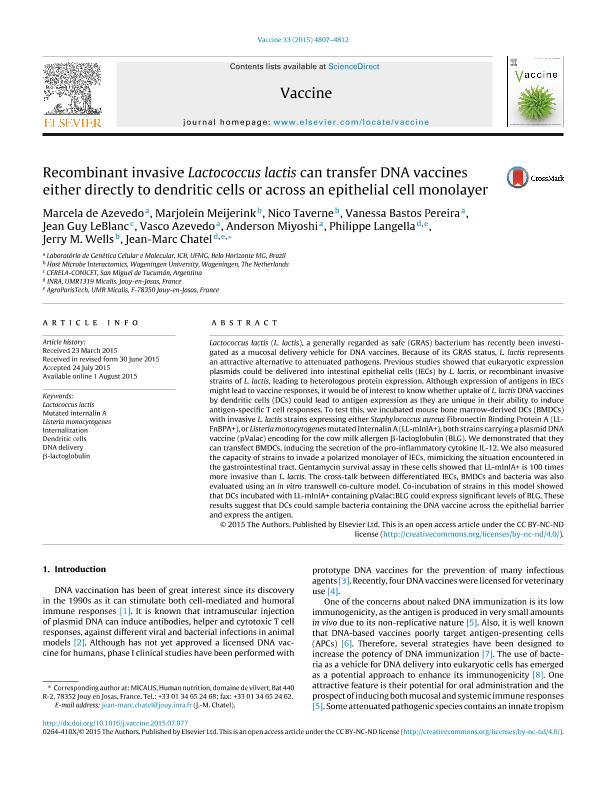Mostrar el registro sencillo del ítem
dc.contributor.author
de Azevedo, Marcela
dc.contributor.author
Meijerink, Marjolein
dc.contributor.author
Taverne, Nico
dc.contributor.author
Bastos Pereira, Vanessa
dc.contributor.author
Leblanc, Jean Guy Joseph

dc.contributor.author
Azevedo, Vasco
dc.contributor.author
Miyoshi, Anderson
dc.contributor.author
Langella, Philippe
dc.contributor.author
Wells, Jerry M.
dc.contributor.author
Chatel, Jean Marc
dc.date.available
2015-11-24T17:08:59Z
dc.date.issued
2015-09-11
dc.identifier.citation
de Azevedo, Marcela ; Meijerink, Marjolein; Taverne, Nico ; Bastos Pereira, Vanessa ; Leblanc, Jean Guy Joseph; et al.; Recombinant invasive Lactococcus lactis can transfer DNA vaccines either directly to dendritic cells or across an epithelial cell monolayer; Elsevier; Vaccine; 33; 38; 11-9-2015; 4807-4812
dc.identifier.issn
0264-410X
dc.identifier.uri
http://hdl.handle.net/11336/2910
dc.description.abstract
Lactococcus lactis (L. lactis), a generally regarded as safe (GRAS) bacterium has recently been investigated as a mucosal delivery vehicle for DNA vaccines. Because of its GRAS status, L. lactis represents an attractive alternative to attenuated pathogens. Previous studies showed that eukaryotic expression plasmids could be delivered into intestinal epithelial cells (IECs) by L. lactis, or recombinant invasive strains of L. lactis, leading to heterologous protein expression. Although expression of antigens in IECs might lead to vaccine responses, it would be of interest to know whether uptake of L. lactis DNA vaccines by dendritic cells (DCs) could lead to antigen expression as they are unique in their ability to induce antigen-specific T cell responses. To test this, we incubated mouse bone marrow-derived DCs (BMDCs) with invasive L. lactis strains expressing either Staphylococcus aureus Fibronectin Binding Protein A (LL-FnBPA+), or Listeria monocytogenes mutated Internalin A (LL-mInlA+), both strains carrying a plasmid DNA vaccine (pValac) encoding for the cow milk allergen β-lactoglobulin (BLG). We demonstrated that they can transfect BMDCs, inducing the secretion of the pro-inflammatory cytokine IL-12. We also measured the capacity of strains to invade a polarized monolayer of IECs, mimicking the situation encountered in the gastrointestinal tract. Gentamycin survival assay in these cells showed that LL-mInlA+ is 100 times more invasive than L. lactis. The cross-talk between differentiated IECs, BMDCs and bacteria was also evaluated using an in vitro transwell co-culture model. Co-incubation of strains in this model showed that DCs incubated with LL-mInlA+ containing pValac:BLG could express significant levels of BLG. These results suggest that DCs could sample bacteria containing the DNA vaccine across the epithelial barrier and express the antigen.
dc.format
application/pdf
dc.language.iso
eng
dc.publisher
Elsevier

dc.rights
info:eu-repo/semantics/openAccess
dc.rights.uri
https://creativecommons.org/licenses/by-nc-nd/2.5/ar/
dc.subject
DENDRITIC CELLS
dc.subject
DNA DELIVERY
dc.subject
INTERNALIZATION
dc.subject
LACTOCOCCUS LACTIS
dc.subject
LISTERIA MONOCYTOGENES
dc.subject
MUTATED INTERNALIN A
dc.subject
Β-LACTOGLOBULIN
dc.subject.classification
Otras Ingenierías y Tecnologías

dc.subject.classification
Otras Ingenierías y Tecnologías

dc.subject.classification
INGENIERÍAS Y TECNOLOGÍAS

dc.title
Recombinant invasive Lactococcus lactis can transfer DNA vaccines either directly to dendritic cells or across an epithelial cell monolayer
dc.type
info:eu-repo/semantics/article
dc.type
info:ar-repo/semantics/artículo
dc.type
info:eu-repo/semantics/publishedVersion
dc.date.updated
2016-03-30 10:35:44.97925-03
dc.identifier.eissn
1873-2518
dc.journal.volume
33
dc.journal.number
38
dc.journal.pagination
4807-4812
dc.journal.pais
Países Bajos

dc.journal.ciudad
Amsterdam
dc.conicet.avisoEditorial
This is an open access article under the CC BY-NC-NDlicense (http://creativecommons.org/licenses/by-nc-nd/4.0/)
dc.description.fil
Fil: de Azevedo, Marcela. Universidade Federal de Minas Gerais; Brasil
dc.description.fil
Fil: Meijerink, Marjolein. Wageningen University. Host Microbe Interactomics; Países Bajos
dc.description.fil
Fil: Taverne, Nico. Wageningen University. Host Microbe Interactomics; Países Bajos
dc.description.fil
Fil: Bastos Pereira, Vanessa. Universidade Federal de Minas Gerais; Brasil
dc.description.fil
Fil: Leblanc, Jean Guy Joseph. Consejo Nacional de Investigaciones Científicas y Técnicas. Centro Científico Tecnológico Tucumán. Centro de Referencia para Lactobacilos (i); Argentina
dc.description.fil
Fil: Azevedo, Vasco. Universidade Federal de Minas Gerais; Brasil
dc.description.fil
Fil: Miyoshi, Anderson. Universidade Federal de Minas Gerais; Brasil
dc.description.fil
Fil: Langella, Philippe. Institut National de la Recherche Agronomique; Francia. AgroParisTech; Francia
dc.description.fil
Fil: Wells, Jerry M.. Wageningen University. Host Microbe Interactomics; Países Bajos
dc.description.fil
Fil: Chatel, Jean Marc. Institut National de la Recherche Agronomique; Francia. AgroParisTech; Francia
dc.journal.title
Vaccine

dc.relation.alternativeid
info:eu-repo/semantics/altIdentifier/url/http://www.sciencedirect.com/science/journal/0264410X
dc.relation.alternativeid
info:eu-repo/semantics/altIdentifier/doi/http://dx.doi.org/10.1016/j.vaccine.2015.07.077
Archivos asociados
